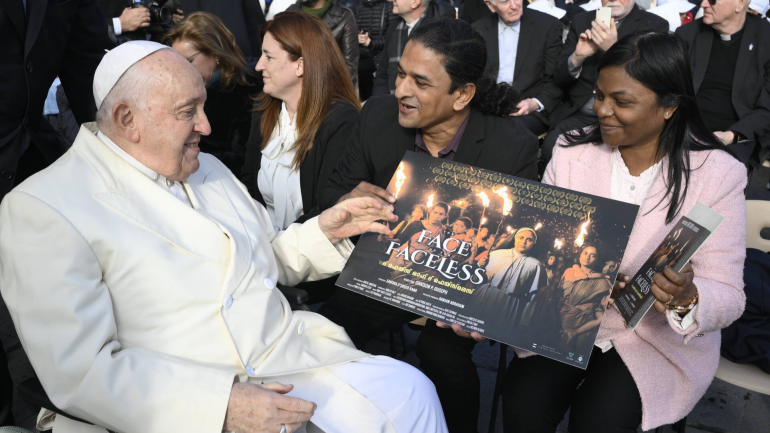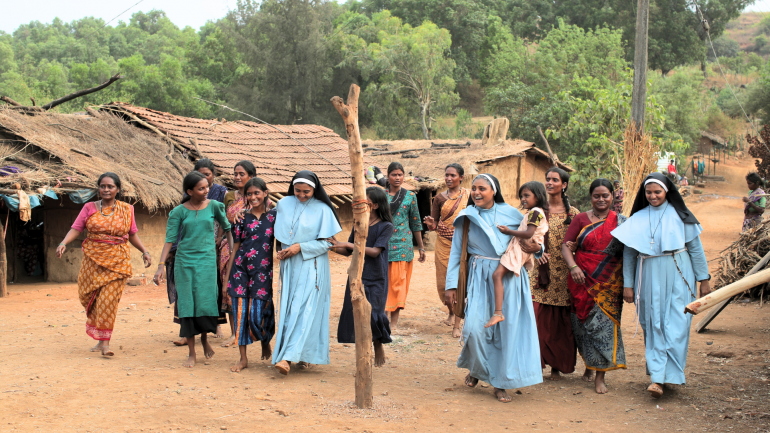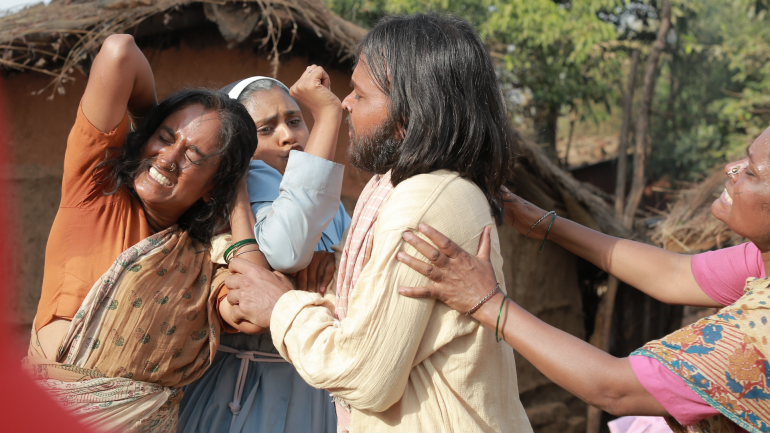Faith, Forgiveness, and Film: Telling the Story of Rani Maria

Originally released in 2023 in Hindi, the Tamil version of the feature film The Face of the Faceless, based on the life of Blessed Rani Maria Vattalil, was launched on July 8, 2025, at the Poondi Madha Basilica in Tamil Nadu.
The release was made possible through the support of Madha TV, a Catholic media network in Tamil Nadu.
The movie tells the story of Rani Maria, a Franciscan Clarist nun from Kerala who worked among tribal communities in central India and was murdered in 1995 for her efforts to free the poor from the grip of moneylenders. She was beatified in 2017.
The film’s director, Dr. Shaison P. Ouseph, shared the story behind the production and the challenges of translating the life of Blessed Rani Maria into a feature film. He is currently Head of the Film, Television, and Digital Video Production Course at the Xavier Institute of Communications, St. Xavier’s College, Mumbai.
Although Dr. Ouseph has many credits to his name ranging from director of photography to art direction, and has produced numerous documentaries and independent feature projects, The Face of the Faceless is his first full-length feature film. In an interview with Radio Veritas Asia, Dr. Ouseph discussed the creative choices, logistical hurdles, and the deeper message that shaped the film.
Motivation Behind the Film
“The story of Blessed Rani Maria came to me through the news about her beatification, but what struck me most was the act of forgiveness by her family,” Ouseph said. “Her mother’s gesture, kissing the hands of her daughter’s killer, was deeply moving. I couldn’t let go of that image.”
For Ouseph, the film became a way to explore not just martyrdom, but also the themes of reconciliation and faith in action. “She fought local injustices, but the values she stood for nonviolence, service, forgiveness are global.”
He described the narrative as one that goes beyond the religious vocation of Sr. Rani Maria. “It’s also a story about how a woman, without power or wealth, was able to challenge a deeply unjust system.”
Research and Development
Before writing the script, Ouseph and his team made several trips to Udaynagar in Madhya Pradesh, where Rani Maria had lived and worked. They met with her family, fellow nuns, villagers, and even Samundar Singh, the man convicted of her murder.
“We didn’t want to rely only on written records,” Ouseph explained. “We needed to meet the people who knew her, hear their stories, and understand the atmosphere she lived in. That’s what gave depth to the film.”
This fieldwork informed the script, which took nearly two years to complete. The production team also read books and articles and held lengthy interviews with those who had been part of her journey. “The challenge was that so much time had passed since the actual events, a good twenty-five years. We had to reconstruct a life that was lived with remarkable simplicity but had a powerful social impact,” he said.
Making a Biopic Under Constraints
Translating a complex, real-life narrative into a film was a major challenge. As Ouseph noted, The Face of the Faceless is not just a retelling of Rani Maria’s life, but a reflection on how faith and courage shape communities. “It’s about her work with the poor, her struggle against exploitation, and how she inspired others to stand up for themselves.”
Casting was a painstaking process, with actors selected from 16 states across India. “It took almost a year to put together the right cast. Many actors spoke different languages, which made coordination a real challenge.”
The film, with a runtime of 136 minutes, was shot over five months with a crew of more than 150 people. The team worked in extreme conditions, temperatures soared to nearly 40 degrees Celsius in central India. “But we had a committed crew who believed in the story,” Ouseph said.
Funding was also an issue. “Many potential investors were hesitant,” he noted. “They were concerned about the religious theme, worried that it might lead to controversy. But along with Sandra D’Souza, we formed our own production house, Tri Light Creations, and partnered with Don Bosco International in Paris to see it through.”
The film had to be edited carefully to meet the standards of India’s Central Board of Film Certification. “We had to revise some scenes and tone down others without losing the message,” he said. “It was a constant balancing act between creative expression and legal boundaries.”
Reception and Impact
Despite the challenges, the film has received widespread acclaim. It has won over 107 international awards and was included in the eligibility list for Best Original Score at the 96th Academy Awards. Audiences in India and abroad have responded strongly, often with deep emotional reactions.
“After screenings, many people came up to us saying it was the first time they cried during a film,” Ouseph recalled. “Our intention wasn’t to make people cry, but to help them reflect on what forgiveness really means.”
He remembers a particular piece of feedback that stood out. “The Editor-in-Chief of Reader’s Digest told me, ‘This film deserves an Oscar.’ He said it had been decades since a film moved him this deeply.”
Clergy and religious also reacted positively. “Several priests and nuns told me the film helped them reconnect with their calling. It reminded them of the deeper purpose of their vocation. In a time when acts of kindness are often questioned, this kind of story helps people see what faith can look like in real life.”
The film was commercially released in India, the Middle East, and Europe, enjoying a six-week run in 100 theatres in Kerala alone. It’s now available in Hindi, Malayalam, Tamil, and Telugu, with English subtitles. French and Spanish versions are scheduled for release by September 2025.
Expanding the Reach
For Ouseph, the goal has always been broader than a theatrical release. “This is not just a film, it’s a tool for education, for dialogue,” he said. Plans are underway to collaborate with dioceses, Catholic schools, lay groups, and parishes forspecial screenings.
“Screenings at retreats, faith gatherings, and institutions are already in motion. It’s especially important that young people see this film, not just for the history, but for the values it portrays.”
He added that community support is crucial: “The encouragement from Catholic and Church media platforms like Radio Veritas is vital. Without this network, we wouldn’t have come this far.”
Reflecting on the journey, Ouseph said, “I didn’t make this film just to tell a story I made it to make people think. Sr. Rani Maria’s courage, her sacrifice, and the act of forgiveness by her family show us what faith looks like when it’s lived fully.”
He hopes the film will encourage audiences to see beyond headlines and rediscover human goodness. “We live in a time when real-life heroes are hard to find. Through this film, we want people to remember that even one person, acting with conviction, can change the world around them.”
Those who would like to organize a screening of The Face of the Faceless may contact Dr. Ouseph at [email protected].












